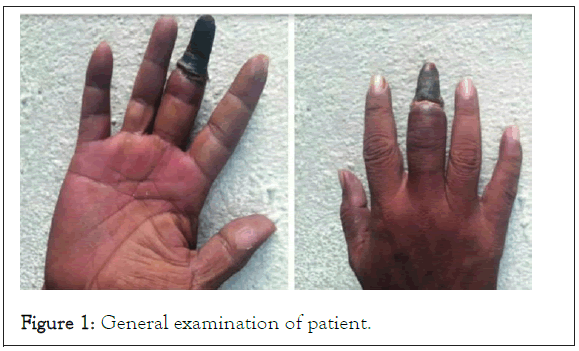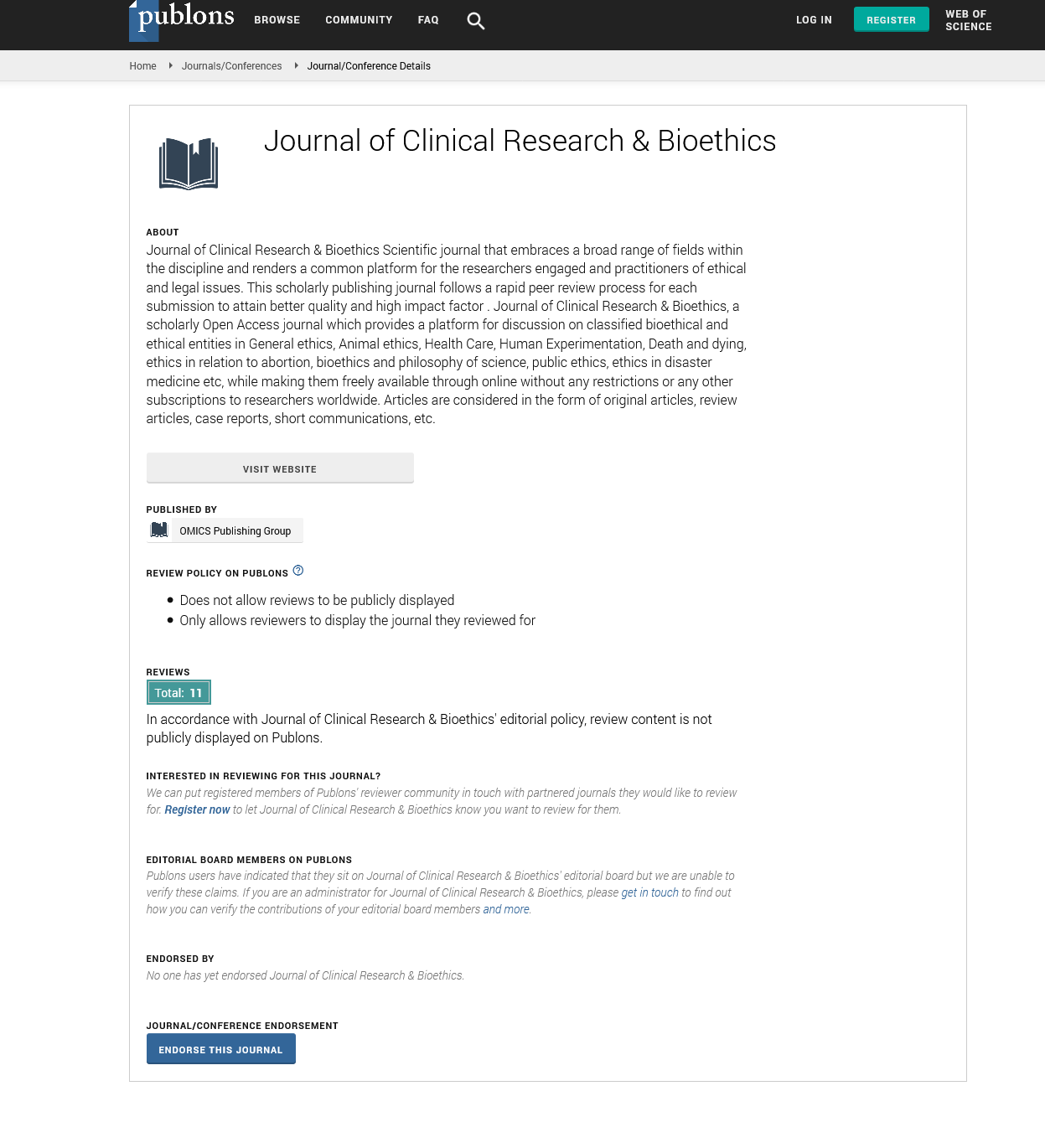Indexed In
- Open J Gate
- Genamics JournalSeek
- JournalTOCs
- RefSeek
- Hamdard University
- EBSCO A-Z
- OCLC- WorldCat
- Publons
- Geneva Foundation for Medical Education and Research
- Google Scholar
Useful Links
Share This Page
Journal Flyer

Open Access Journals
- Agri and Aquaculture
- Biochemistry
- Bioinformatics & Systems Biology
- Business & Management
- Chemistry
- Clinical Sciences
- Engineering
- Food & Nutrition
- General Science
- Genetics & Molecular Biology
- Immunology & Microbiology
- Medical Sciences
- Neuroscience & Psychology
- Nursing & Health Care
- Pharmaceutical Sciences
Case Report - (2021) Volume 12, Issue 4
A Case Report on Buerger’s Disease
Chillara Tejaswi*Received: 12-Apr-2021 Published: 03-May-2021, DOI: 10.35248/2155-9627.21.12.377
Abstract
Thromboangiitis Obliterans (TAO) is also known as buerger's disease. It is a vascular disease characterised by a segmental, non-atherosclerotic inflammation of the small and medium sized arteries and veins of upper and lower extremities. Buerger’s disease develops most frequently in men who smoke and tobacco use. Buerger’s disease is found worldwide, and the aetiology is unknown. But use or exposure to tobacco is central to the initiation and prognosis of the disease. Here we representing such a case of buerger's disease in a 28 years old male patient with chief complaints of severe rest pain in the both upper limbs since last three months, burning sensation of both hands in the past 15 days and blackish discolouration if index and middle finger tips in the past two days.
Keywords
Thromboangiitis obliterans; Non-atherosclerotic inflammation; Tobacco
Introduction
Thromboangiitis Obliterans (TAO) is a non-atherosclerotic, segmental inflammatory disease that most commonly affects the small and medium sized arteries and veins in the upper and lower extremities. Cigarette smoking has been implicated as the main aetiology of this disease. TAO was first described in 1879, when Felix von winiwarter, an Australian surgeon. After those twenty-nine years later, Leo Buerger described in detailed and accurate pathological findings of the 11 amputated limbs. TAO affects men between 25 and 35 years and involved arteries, veins and nerves of arm and legs. Extraordinary manifestations of TAO can involve the gastrointestinal, cerebrovascular, coronary and renal arteries [1,2].
Epidemiology
Although buerger’s disease occurs worldwide, it is more prevalent in the Middle East and Far East than in North America and Western Europe. The prevalence of this disease among all patients with peripheral arterial disease varies from as low as 0.5 to 5.6 in Western Europe to as high as 45% to 63% in India, 16% to 66% in Korea and Japan, and 80% in Israel among Jews of Ashkenazi ancestry. Several studies have reported an increase in the prevalence of the disease in women ranging from 11% to 23% [3,4].
Signs and symptoms
The symptoms begin with ischemia of the small vessels in arms, legs, hands and feet. Involvement of the large arteries is unusual and rarely occurs in the absence of occlusive disease of small vessels. As disease progresses calf claudication and eventually ischemic pain at rest and ischemic ulceration on the toes, feet, fingers may develop. Other signs and symptoms of the disease may include numbness and/or tingling in the limbs, skin ulceration and gangrene of the digits. Superficial thromboangiitis and Raynaud’s phenomenon occur in approximately 40% of patients with thromboangiitis obliterans.
Diagnosis
There are no such diagnostic tests to diagnose Thromboangiitis obliterans or Buerger’s disease. However, a lot of conclusions can be generated if the diagnosis of atherosclerosis is mixed up with thromboangiitis obliterans.
Although Shionoya’s criteria, papa’s scoring system, and Olin's criteria are frequently referred to in the literature.
Clinical signs
• Drop in skin temperature.
• Intermittent claudication.
• Resting pain in soles and palms.
• Painful ulceration or gangrene.
Physical examination
Lower temperature of the skin in the upper or lower limbs, or in the distal parts of the toes or fingers.
Impaired arterial pulsation in the peripheral segment of a vessel, with retained proximal pulse.
Arteriography
• Multiple segmental occlusions of distal arterial sections.
• Chronic vascular occlusion due to secondary thrombosis.
• An absence of atherosclerotic lesions, such as calcification vascular walls.
Aetiology
The cause of Buerger’s disease remains unknown so far. However, the development of TAO is strongly associated with heavy use of tobacco, and the prognosis of the disease is closely linked with continued use. By using an antigen-sensitive thymidine-incorporation assay, Adar showed that patients with TAO have an increased cellular sensitivity to types I and III collagen compared to those patients with healthy males. Some studies also show a higher prevalence of Human Leukocyte Antigen (HLA) A9, A54 and B5 suggesting a genetic component to the disease.
Pathogenesis
The pathogenic features of TAO are categorized in three phases including acute, sub-acute, and chronic according to the inflammatory cells. In contrast to other types of vacuities, the structure of the affected vessel, and particularly the internal elastic lamina, remains intact in all three phases of TAO.
The main characteristic of acute phase is hyper cellular and inflammatory thrombus with minimum inflammation in the vascular wall of the affected vessel. The Poly-Morph-Nuclear (PMN) leukocytes are predominant cells at the site of inflammation in this phase. In sub-acute phase, PMNs in the micro abscesses are surrounded by a granulomatous inflammation, which causes to organization and recanalization of the thrombus. Finally, the mature thrombus with vascular fibrosis is observed in the end-stage phase.
Case Report
A 28-year-old male presented with severe rest pain in the both upper limbs last three months, burning sensation of both hands since 15 days and blackish discoloration of index and middle finger tips last two days. He was a chronic smoker for past 8 years, smoking one and half pack of cigarettes daily. He was not alcoholic and no significance family history was observed. He has past history of hypertension on medication of telmisartan 40 mg/od since 2 months and diagnosed with diabetes two days before.
General examination
On general examination patient was conscious and coherent blood pressure 180/100 mghg, GRBS: 304 mg/dl, pulse rate 72 bpm, respiratory rate 19 bpm (Figure 1).

Figure 1: General examination of patient.
Smoking cessation
Day one treatment as follows:
Injection: Ceftriaxone 1 gm/iv/od.
It is an antibiotic and prescribed foe bacterial infection.
Injection: Aspirin 325 mg/iv/od.
It is prescribed for antiplatelet action.
Injection: Pantoprazole .40 mg/iv/od.
It is prescribed for to decrease acid secretion in stomach.
Injection: Regular Insulin 10 u/sc/bd.
It is prescribed for to regulate blood sugar levels.
Tablet: Neurokind 500 mg/od.
It is prescribed for nutrition supplementation.
Day 2 treatment continues as same treatment of day 1.
Day 3 treatment continues as SAE treatment with aspirin and pantoprazole in oral form.
Review
After the days treatment he feels better and the signs and symptoms are slowly decreased.
Results and Discussion
The diagnosis of in this case is mainly based on physical examination and past history of smoking (one and half pack per day last 8 years) and onset before the age of 50 years.
The mainstay of treatment for buerger’s disease is the cessation of all tobacco products. Typically, buerger’s disease does not affect larger vessels but few cases have been described. The exact mechanism of pathophysiology in buerger’s disease is unknown, but reviewed histopathology from previous studies has shown some insight into the disease process. According to an immunological study, TAO is an endarteritis due to cellular immunity mediated by T-cell and humoral immunity mediated by B cell and associated with activation of macrophages or dendritic cells in the intima wall [5,6].
Conclusion
The standard treatment for Buerger’s disease is not available so far. Smoking cessation is the only option for affective treatment outcomes as well as avoid all sources which contain tobacco.
REFERENCES
- Caroline D, Aminuddin M. A Middle-aged woman suffering Buerger’s Disease. CCJ. 2020; 1(1): 6.
- Chavarria IJR, Gutierrez JDB. Thromboangiitis obliterance (Buerger’s disease). Ann Med Surg. 2006; 7: 79-82.
- Arkkia PET. Thromboangiitis obliterans. Orphanet J Rare Dis. 2006; 1:14
- Małecki R, Kluz J, Dołyk JP, Adamiec R. The pathogenesis and diagnosis of TAO: Is still a mystery. Adv Clin Exp Med. 2015; 24(6): 1085-1097.
- kumar AV, Tiwari R, Swamy VRP. Thromboangiitis obliterans (Buerger’s Disease)-current practices. J Inflamm Res. 2013; 2013:1-9.
- Navi HA, Bilal M, Yousuf S. Ischemic colitis in Buerger’s disease : Case presentation and review.Cureus. 2020; 12(5): e8303.
Citation: Tejaswi C (2021) A Case Report on Buerger’s Disease. J Clin Res Bioeth. 12:377.
Copyright: © 2021 Tejaswi C. This is an open-access article distributed under the terms of the Creative Commons Attribution License, which permits unrestricted use, distribution, and reproduction in any medium, provided the original author and source are credited.

